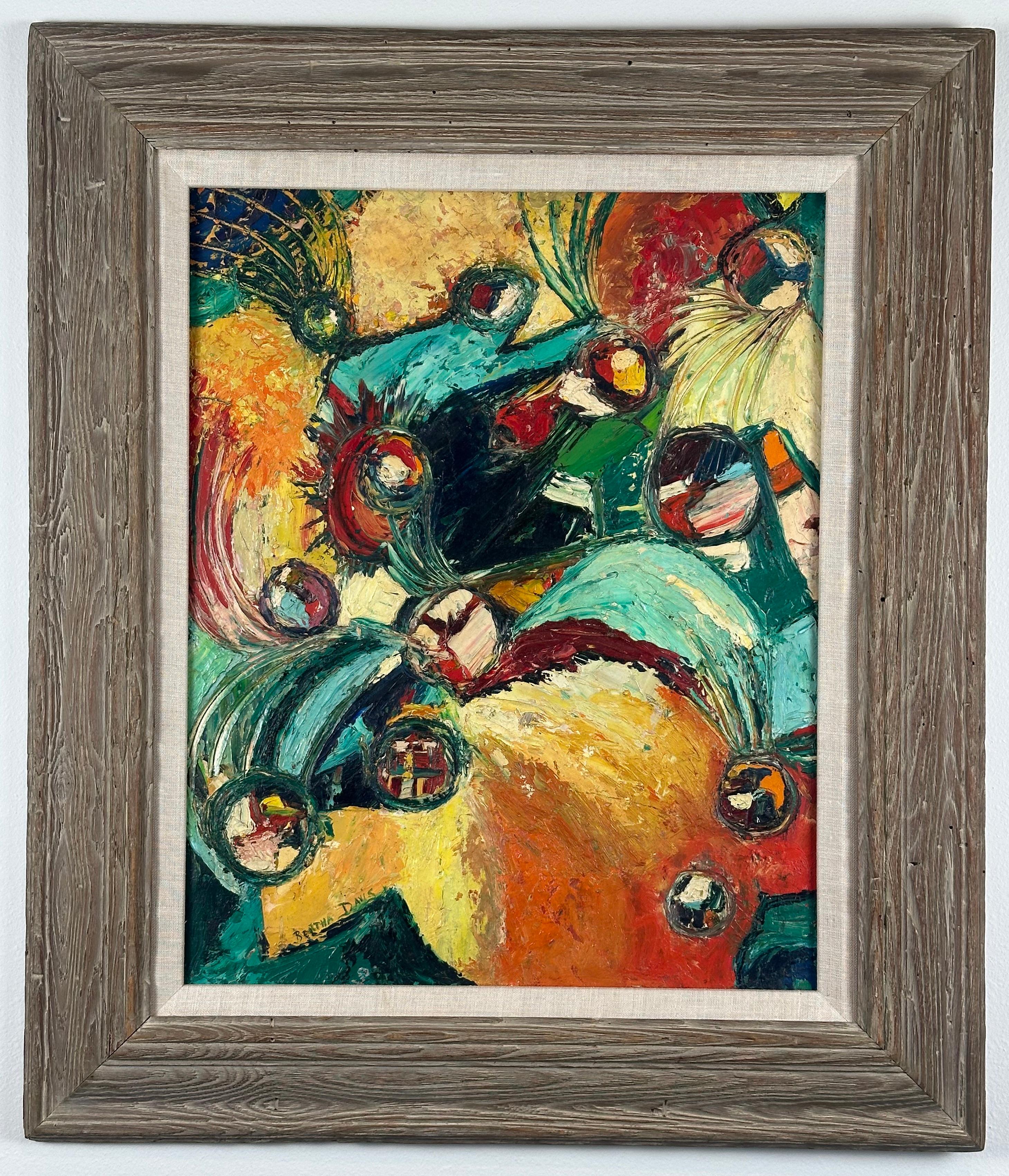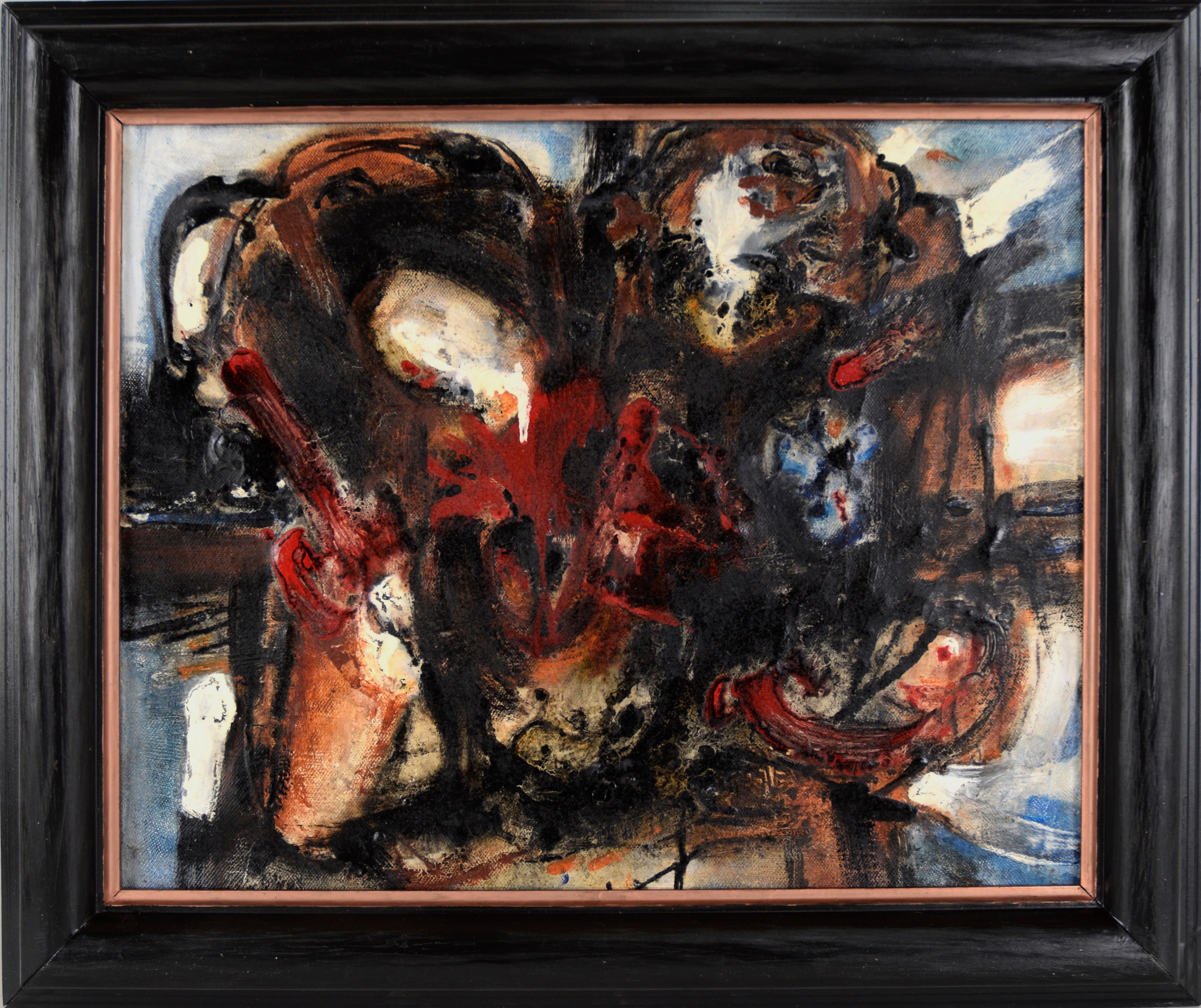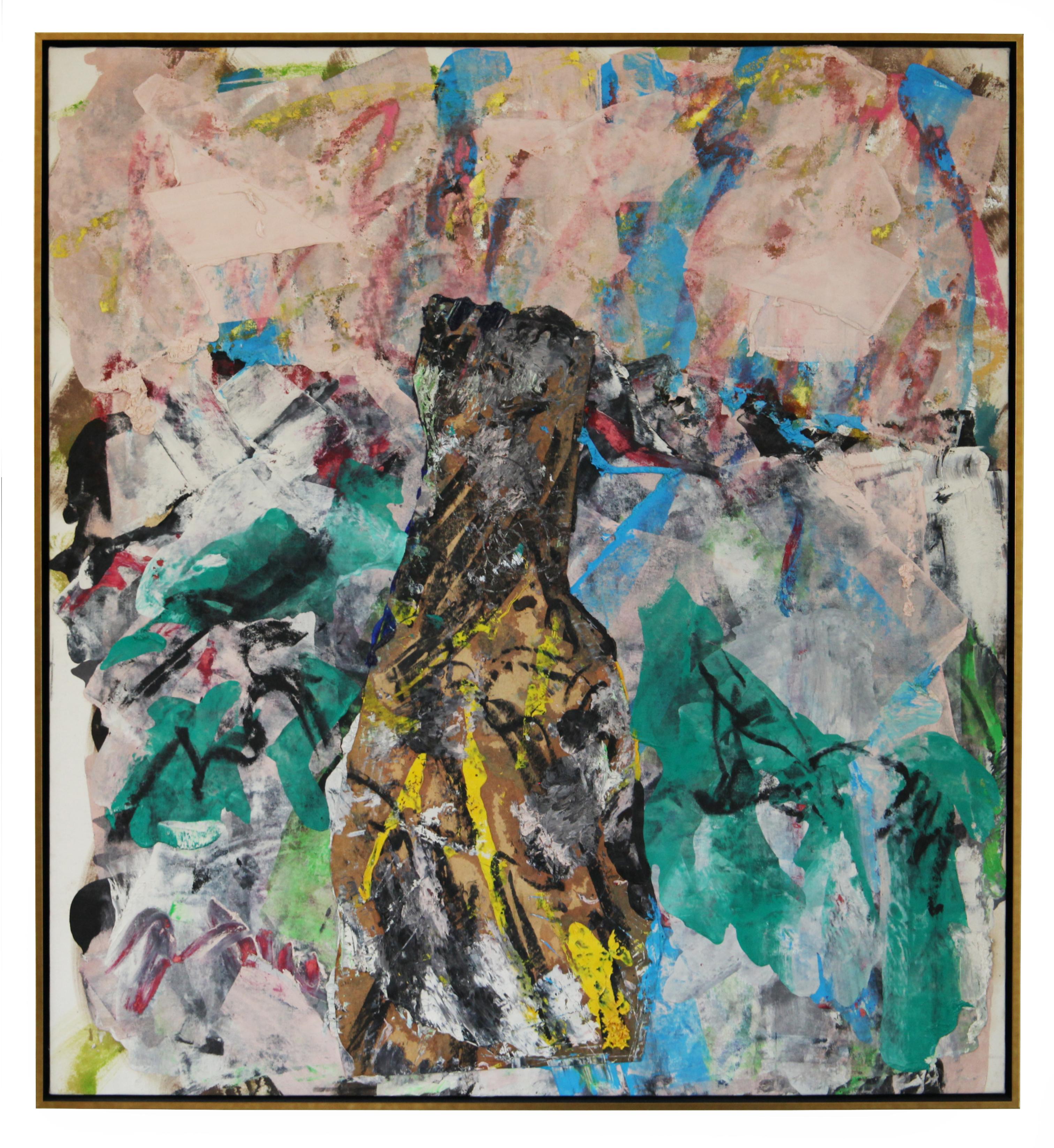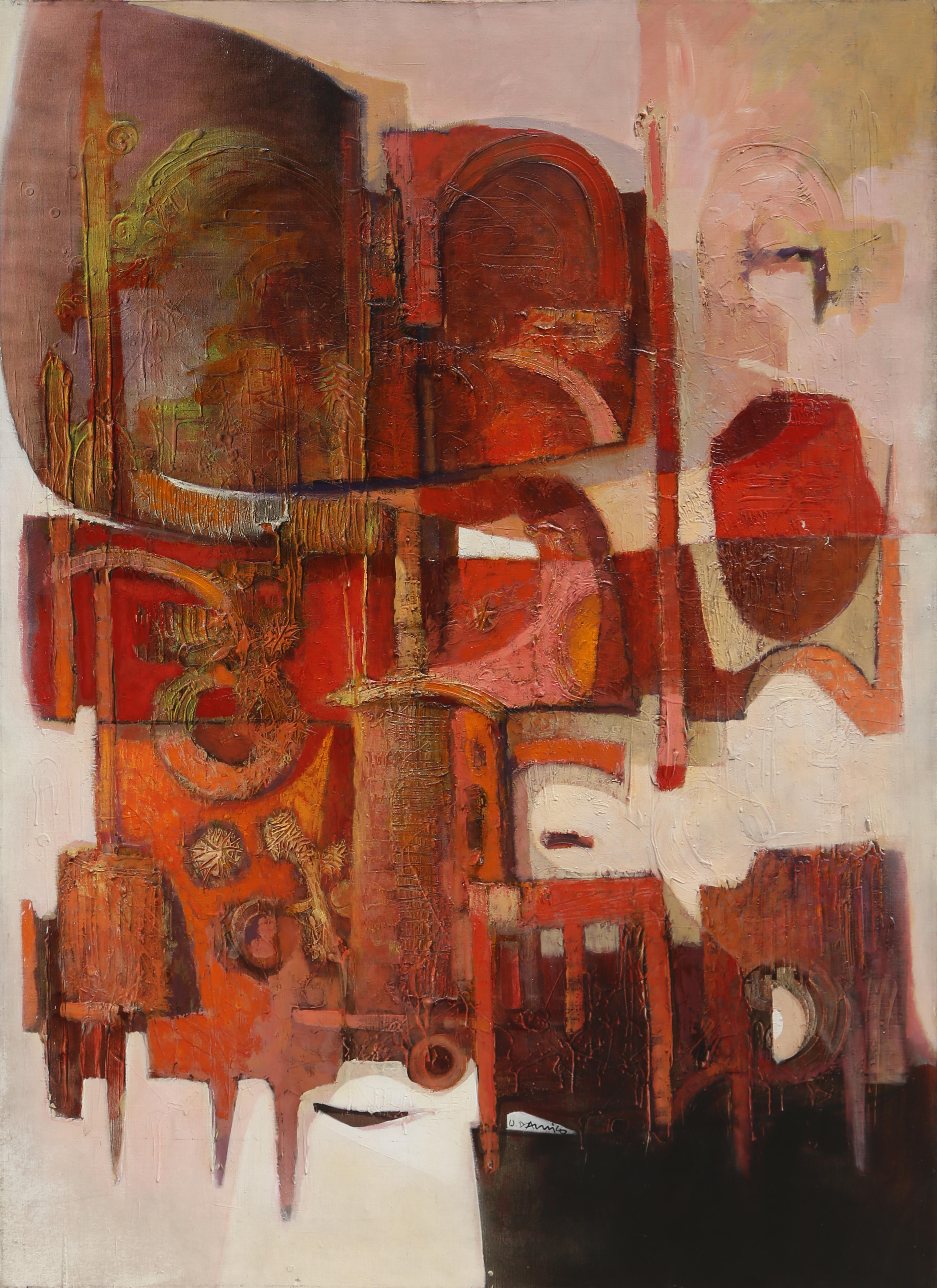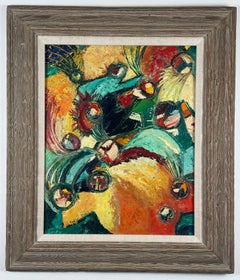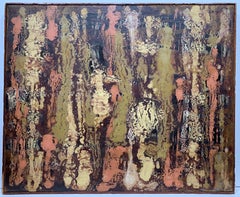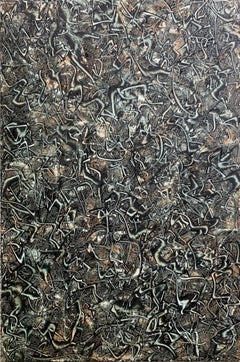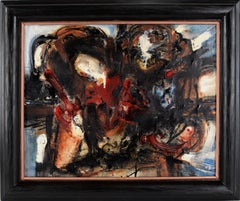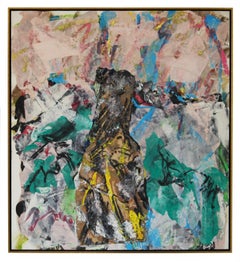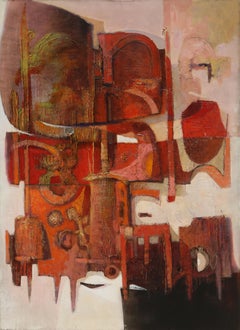Items Similar to Untitled (Abstract Expressionist Painting)
Want more images or videos?
Request additional images or videos from the seller
1 of 13
Jesse Redwin BardinUntitled (Abstract Expressionist Painting)ca. 1960
ca. 1960
$4,000
£3,114.27
€3,541.82
CA$5,753.88
A$6,321.66
CHF 3,303.74
MX$75,391.06
NOK 41,834.28
SEK 38,972.16
DKK 26,466.14
About the Item
Jesse Redwin Bardin (1923-1997). Untitled, ca. 1960.
Oil on canvas, 18 x 31 inches; 21.5 x 36.5 inches framed. Signed lower right.
Provenance: Private collection, Philadelphia; Finkel Gallery, Philadelphia, PA.
Born in Elloree, South Carolina, Jesse Redwin Bardin became nationally recognized for his evocative abstract paintings that seem to glow from within. His paintings tend to be primarily monochromatic, dealing with elemental concepts, contemplation and activity.
Bardin was the recipient of numerous awards and honors including the South Carolina Guild of Artists in 1958, the Ford Foundation Purchase Award in 1960 and inclusion in the American Federation of Arts, 50 Artists - 50 States traveling exhibition. In 1982, the Columbia Museum of Art launched a career retrospective. Bardin's work can be found in museum collectors including the Mint Museum, the North Carolina Museum of Art, and the Gibbes Museum among others.
- Creator:Jesse Redwin Bardin (born after 1923-died after 1997, American)
- Creation Year:ca. 1960
- Dimensions:Height: 36.5 in (92.71 cm)Width: 21.5 in (54.61 cm)Depth: 1.5 in (3.81 cm)
- Medium:
- Movement & Style:
- Period:
- Condition:
- Gallery Location:Wilton Manors, FL
- Reference Number:1stDibs: LU245214293112
About the Seller
4.9
Platinum Seller
Premium sellers with a 4.7+ rating and 24-hour response times
Established in 2007
1stDibs seller since 2015
435 sales on 1stDibs
Typical response time: 4 hours
- ShippingRetrieving quote...Shipping from: Wilton Manors, FL
- Return Policy
More From This Seller
View AllUntitled (Abstract Expressionist)
By Murray Hantman
Located in Wilton Manors, FL
Murray Hantman (1904-1999). Untitled, ca. 1950-55. Oil on canvas measures 20 x 26 inches, 26 x 32 inches in silver leaf vintage frame.. Signed lower right. Excellent condition with ...
Category
Mid-20th Century Abstract Expressionist Abstract Paintings
Materials
Canvas, Oil
$3,000 Sale Price
25% Off
Untitled (Abstract Expressionist Painting)
By Bertha Davis
Located in Wilton Manors, FL
Bertha G. Davis (1911-1997)
Untitled, ca. 1960's
Oil on cradled masonite panel.
16 x 20 inches; 24 x 28 inches framed.
Signed lower left. Artist estate stamp on verso.
Vintage custom wormy chestnut frame.
A painter of cityscapes, landscapes, and abstracts in Texas, Bertha G Davis was primarily a self-taught artist whose style was influenced by her early life experiences in pre-World War II Lithuania and later Mexico. Her style is expressionistic*, relying on color to denote her profound feelings. She works primarily in watercolor and acrylic with some mixed media*.
She is the daughter of Abraham and Dvora Germaize of Vilna, Lithuania and grew up in Jewish ghettos in Vilna, Alita, and Kovno. Davis was influenced by her father who was a decorative wood-worker and carpenter in Lithuania. The family of five daughters and a son escaped to Mexico City in the late 1920’s because of Jewish oppression. The images and emotions she experienced had no outlet.
She was known as a beauty, and at age 17 was named Jewish Miss Mexico, barely able to speak Spanish having just emigrated from Eastern Europe. Irving Davis, a merchant from Texas who had also come from Eastern Europe via Cuba, saw her at this event where she was crowned Jewish Miss Mexico, and three days later asked for her hand in marriage. They moved to a small town in Texas, raising a family.
Her daughter, Sylvia, was born when Davis was 20 and they were inseparable. As Sylvia became an actress, painter, and sculptor, Davis was amazed at the capacity for creativity. Davis didn’t begin her own artistic journey until she was 47, when her daughter Sylvia Caplan encouraged her to try. She was inspired by this daughter who gave her a drugstore palette of watercolors, paper and brushes and told her to “just try.” Davis did not put down her palette and brushes until her death in 1997.
Bertha G Davis was primarily self-taught but maintained a style oriented toward color and texture that reflected her strong feelings. Most of her early work was done while she lived in McAllen, Texas where she was known for her contribution to art and showed her work and the work of other artists at the Bertha Davis Gallery.
She studied with Stewart Van Orden, at Pan American College in 1960-61; and was a student at the Art Institute San Miguel Allende, Mexico, 1965. She was also a student of Harold Phenix...
Category
Mid-20th Century Abstract Expressionist Abstract Paintings
Materials
Masonite, Oil
$975 Sale Price
35% Off
Abstract Expressionist mi-century modern painting
Located in Wilton Manors, FL
Beautiful mid-century Abstract Expressionist color field painting. Oil on canvas, 16 x 20 inches; 16.5 x 20.5 inches in simple vintage wood strip frame original to the piece. Signed ...
Category
Mid-20th Century Abstract Expressionist Abstract Paintings
Materials
Canvas, Oil
$780 Sale Price
35% Off
Untitled (ER49) Abstract Expressionist painting
Located in Wilton Manors, FL
Edward Pechmann Renouf (1906-1999). Oil on panel measures 16 x 24 inches. Signed lower margin. Excellent condition.
Provenance: Allan Stone Pr...
Category
1970s Abstract Expressionist Abstract Paintings
Materials
Masonite, Oil
$1,200 Sale Price
20% Off
Untitled Abstract Expressionist painting
By Desmond McLean
Located in Wilton Manors, FL
Desmond Mclean (1929-2015).
Untitled, ca. 1965
oil on canvas
16 x 20 inches; 18 x 22 inches in wood frame.
Born: Ireland
Studied: Heatherly School of Art, London; American Sc...
Category
Mid-20th Century Abstract Expressionist Mixed Media
Materials
Paper, Charcoal, Gouache, Color Pencil
Untitled Abstract Expressionist composition
By Eve Peri
Located in Wilton Manors, FL
Beautiful ca. 1955 oil painting by American artist, Eve Peri. Oil on illustration board, panel measures 10 x 15 inches; 15.75 x 20.75 inches framed. Signed lower left. Excellent condition.
Vintage...
Category
Mid-20th Century Abstract Abstract Paintings
Materials
Oil, Illustration Board
$975 Sale Price
35% Off
You May Also Like
Dynamic Mid-Century Abstract Expressionist Piece
Located in Soquel, CA
Dynamic Mid-Century Abstract Expressionist Piece by Andres R. Montani (Uruguayan b. 1918 d. 2000)
Bold and beautiful 1960s abstract expressionist oil painting. This painting is cons...
Category
1960s Post-Modern Abstract Paintings
Materials
Oil
Abstract Composition II, Abstract Expressionist Painting by Jenik Cook
By Jenik Cook
Located in Long Island City, NY
Artist: Jenik Cook, American (1940 - )
Title: Abstract Composition II
Year: 2011
Medium: Oil on Canvas, signed and dated l.l. and verso
Size: 24 x 36 in. (60.96 x 91.44 cm)
Category
1980s Abstract Expressionist Abstract Paintings
Materials
Canvas, Acrylic
Untitled
By Michael Goldberg
Located in Austin, TX
Waterline Fine Art, Austin, TX is pleased to present the following work:
Oil, pastel, and paper collage on canvas. Signed and dated verso.
52.75 x 47.75 in.
54 x 49 in. (framed)
Gilded floater frame.
Provenance
Compass Rose, Chicago
Born Sylvan Irwin Goldberg in 1924 and raised in the Bronx, Michael Goldberg was an important figure in American Abstract Expressionism, who began taking art classes at the Art Students League in 1938. A gifted student, Goldberg finished high school at the age of 14 and enrolled in City College. He soon found New York’s jazz scene to be a more compelling environment, and he began skipping classes in favor of the Harlem jazz clubs near campus. Goldberg’s love of jazz would become a lifelong passion and a key component to his approach to composition in his paintings.
From 1940 to 1942, like many of the leading artists of the New York School, Goldberg studied with Hans Hofmann. In 1943, he put his pursuit of painting on hold and enlisted in the U.S. Army. Serving in North Africa, Burma, and India, Goldberg received a Purple Heart and a Bronze Star before being discharged in 1946. After his service, he traveled and worked in Venezuela before returning to the United States, settling back in New York and resuming studies with Hofmann and at the Art Students League.
Living downtown and frequenting the Cedar Bar, Goldberg befriended many of the artists of the New York School. In 1951, his work was included in the groundbreaking Ninth Street Show, co-organized by Leo Castelli, Conrad Marca-Relli, and the Eighth Street Club, and featuring the work of - among others - Hofmann, Jackson Pollock, Willem de Kooning, and Franz Kline. In 1953, the Tibor de Nagy...
Category
1980s Abstract Expressionist Abstract Paintings
Materials
Canvas, Pastel, Mixed Media, Oil, Handmade Paper
Large Abstract Expressionist painting by Oskar D'Amico
By Oskar D'Amico
Located in Long Island City, NY
Artist: Oskar Maria D'Amico, Italian (1923 - 2003)
Title: Untitled
Year: 1967
Medium: Oil on Canvas, signed
Size: 66 x 48 in. (167.64 x 121.92 cm)
Category
1960s Abstract Expressionist Abstract Paintings
Materials
Oil
Untitled Sketch II
By Friedel Dzubas
Located in Three Oaks, MI
Friedel Dzubas, a prominent figure in the New York School, made a significant mark within the Color Field painting movement during the mid-twentieth century, persisting in his artist...
Category
1970s Abstract Expressionist Abstract Paintings
Materials
Canvas, Acrylic
Price Upon Request
Abstract Expressionist Painting Titled, "Shift"
Located in San Diego, CA
This is a one of a kind original abstract expressionist painting by local San Diego artist, Kelsey Overstreet. This is an acrylic on canvas and its d...
Category
2010s Abstract Expressionist Abstract Paintings
Materials
Acrylic
